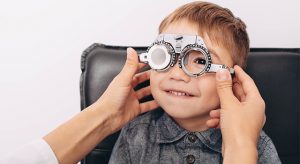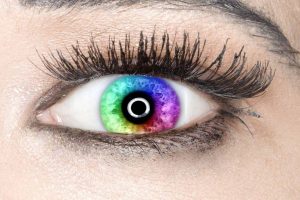Both lazy eye and crossed eye are functional vision problems – but there are important differences.
It might be difficult to tell the difference between strabismus (crossed eye) and amblyopia (lazy eye) because the two vision issues have certain similarities.
Here’s a comparison to better understand these two eye conditions.
Other names
Crossed eyes are also referred to as:
- Strabismus
- Eye turn
- Squint or Wall eye
Lazy eye is also referred to as:
- Amblyopia
- Weak eye
Definition
Crossed eyes is when both eyes do not look in the same direction at the same time.
This occurs when one or both eyes turn in, out, up, or down for part or all of the time
Lazy eye is a condition in which one eye fails to develop clear vision.
This occurs for reasons other than an eye health problem and cannot be corrected with glasses alone.
Frequently, with lazy eyes, the eyes remain perfectly straight, and are not crossed.
Cause
Crossed eyes can present at birth or a person develop later in life.
This can also occur as a result of an accident or another medical condition.
Genetics also plays a role: if you or your spouse has strabismus, your children are more likely to develop the condition.
In strabismus, the control and function of the eyes are impaired due to neurological or anatomical issues. The issue could stem from the muscles themselves, the nerves, or the brain’s vision centers that control binocular vision.
The majority of cases of strabismus are caused by a miscommunication between the brain and the eyes, rather than a muscular condition. The brain has trouble combining the images from both eyes into a single, three-dimensional image since the eyes are pointing in opposite directions.
Amblyopia usually develops during infancy and early childhood.
The following are the most common causes of amblyopia:
- Anisometropia – different prescriptions in each eye
- Constant blockage of an eye due to trauma, lid droop, etc.
- Strabismus is also common cause of amblyopia
Contact an eye doctor near you who can diagnose lazy and crossed eyes.
SEE RELATED: Parent’s Checklist to Identify a Vision Problem
Symptoms
Crossed eyes are seen as a visible eye turn, where one eye is pointing in a different direction to the other. This is the most prominent indication of strabismus.
Strabismus patients may have more frequent symptoms, including:
- Blurry or double vision
- Headaches
- Eye and/or general fatigue
- Eye strain and/or pain
- Poor depth perception
Patients with strabismus may report:
- Clumsiness
- Difficulty driving
- Difficulty reading
- Difficulty with sports activities
Amblyopia is not detectable through simple observation because the eyes appear to be normal, with no obvious signs of an eye turn or reduced vision in one eye.
Symptoms include:
- Clumsiness
- Difficulty catching and throwing objects
- Eye strain
- Fatigue while doing near work
- Head turn or tilt
- Poor depth perception
- Squinting or shutting an eye
Treatment
Crossed eyes: Many times surgery is recommended as the best treatment option. While this can decrease the amount of eye turn, it doesn’t solve the underlying functional vision issue of poor eye teaming.
As a result, many surgical procedures are frequently required.
By allowing the person to improve their eye teaming skills, vision therapy addresses the core issue.
In other circumstances, a combination of vision therapy and surgery may be the best option. Even in these circumstances, vision therapy should be used first as a non-invasive treatment option.
The traditional therapy involves prescription glasses and then a vision therapy program.
Lazy eye: Applying an eye patch to the non-amblyopic eye is often part of a comprehensive program.
Atropine eye drops can be used to ‘blur’ the good eye by obscuring its vision.
Patching alone, as with strabismus, does not treat the core cause of the issue, which is a lack of eye teaming skills development.
Vision therapy should be considered in conjunction with patching and/or prescribing glasses to build eye teaming abilities and improve functional vision in order to avoid regression.
LEARN MORE: Vision Therapy for Children
Schedule an appointment with an eye doctor near you to start vision therapy treatment.
Here’s a comparison to better understand these two eye conditions that are sometimes confused, but their cause and treatment can vary significantly.










